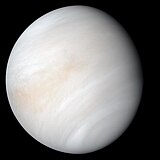Pilt:PIA23791-Venus-RealAndEnhancedContrastViews-20200608 (cropped).jpg
Ilme

Seo proovikaehusõ suurus: 600 × 600 pikslit. Tõõsõq eräldüsvõimõq: 240 × 240 pikslit | 480 × 480 pikslit | 768 × 768 pikslit | 1096 × 1096 pikslit.
Algteedüstü (1096 × 1096 pikslit, 30 KB, MIME-tüüp: image/jpeg)
Teedüstü aolugu
Klõpsaq kuupäävä/kelläao pääl, et nätäq määne taa teedüstü sis oll'.
| Kuupäiv/Kelläaig | Väiku pilt | Suurus | Pruukja | Seletüs: | |
|---|---|---|---|---|---|
| parhillanõ | 9. hainakuu 2020, kell 23:40 |  | 1096 × 1096 (30 KB) | PhilipTerryGraham | File:PIA23791-Venus-RealAndEnhancedContrastViews-20200608.jpg cropped 51 % horizontally using CropTool with precise mode. |
Teedüstüpruukminõ
Taa pildi pääle näütäs lehekülg:
Globaalne failipruukminõ
Järgmädseq muuq vikiq pruukvaq seod faili:
- Faili pruukminõ vikin ary.wikipedia.org
- Faili pruukminõ vikin arz.wikipedia.org
- Faili pruukminõ vikin ast.wikipedia.org
- Faili pruukminõ vikin as.wikipedia.org
- Faili pruukminõ vikin awa.wikipedia.org
- Faili pruukminõ vikin azb.wikipedia.org
- Faili pruukminõ vikin az.wikipedia.org
- Faili pruukminõ vikin ban.wikipedia.org
- Faili pruukminõ vikin bat-smg.wikipedia.org
- Faili pruukminõ vikin ba.wikipedia.org
- Faili pruukminõ vikin bcl.wikipedia.org
- Faili pruukminõ vikin be-tarask.wikipedia.org
- Faili pruukminõ vikin be.wikipedia.org
- Faili pruukminõ vikin bew.wikipedia.org
- Faili pruukminõ vikin bg.wikipedia.org
- Faili pruukminõ vikin bh.wikipedia.org
- Faili pruukminõ vikin bjn.wikipedia.org
- Faili pruukminõ vikin bn.wikipedia.org
- Faili pruukminõ vikin bo.wikipedia.org
- Faili pruukminõ vikin br.wikipedia.org
- Faili pruukminõ vikin bs.wikipedia.org
- Faili pruukminõ vikin btm.wikipedia.org
- Faili pruukminõ vikin bxr.wikipedia.org
- Faili pruukminõ vikin ca.wikipedia.org
- Faili pruukminõ vikin cdo.wikipedia.org
- Faili pruukminõ vikin ceb.wikipedia.org
- Faili pruukminõ vikin ce.wikipedia.org
- Faili pruukminõ vikin chr.wikipedia.org
- Faili pruukminõ vikin ckb.wikipedia.org
- Faili pruukminõ vikin co.wikipedia.org
- Faili pruukminõ vikin crh.wikipedia.org
- Faili pruukminõ vikin cr.wikipedia.org
- Faili pruukminõ vikin csb.wikipedia.org
- Faili pruukminõ vikin cs.wikipedia.org
- Faili pruukminõ vikin cu.wikipedia.org
- Faili pruukminõ vikin cv.wikipedia.org
- Faili pruukminõ vikin cy.wikipedia.org
- Faili pruukminõ vikin dag.wikipedia.org
- Faili pruukminõ vikin da.wikipedia.org
- Faili pruukminõ vikin de.wikipedia.org
- Faili pruukminõ vikin dga.wikipedia.org
- Faili pruukminõ vikin din.wikipedia.org
- Faili pruukminõ vikin diq.wikipedia.org
- Faili pruukminõ vikin dsb.wikipedia.org
- Faili pruukminõ vikin dty.wikipedia.org
- Faili pruukminõ vikin el.wikipedia.org
Kaeq seo faili vikidevaihõlist pruukmist.




